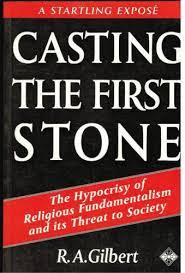Articles/Essays – Volume 26, No. 4
Anti-Christian Fundamentalism | R. A. Gilbert, Casting the First Stone: The Hypocrisy of Religious Fundamentalism and Its Threat to Society
R. A. Gilbert’s book, Casting the First Stone, is one of an increasing number of written responses to uninformed attacks by Fundamentalists against new religious movements and any other religious group which does not fit within the Fundamentalists’ “uncompromising version of the Christian faith” (16; see, e.g., Karl Keating, Catholicism and Fundamentalism, The Attack on “Romanism” by “Bible Christians” [San Francisco: Ignatius Press, 1988], and Daniel C. Peterson and Stephen D. Ricks, Offenders
for a Word: How Anti-Mormons Play Word Games to Attack the Latter-day Saints [Salt Lake City: Aspen Books, 1992]). These critics are fundamentally dogmatic and feel absolutely justified by the Bible to attack every “cult” they believe deviates from essential Christian theology even if many of their descriptions and characterizations of the beliefs and practices of these “non-Christian” religions are either distortions or ignorant.
Although many of Gilbert’s examples are from the more lunatic fringe of the Fundamentalist community he also chronicles distortions utilized by less strident groups and shows that Funda mentalist targets are not limited to new religious movements (such as Mor mons, Jehovah Witnesses, Unification church, Hare Krishna, etc.)—they also attack older, established movements such as Buddhism, Hinduism, Islam, and Roman Catholicism (81, 173). Gilbert, who is one of the world’s leading experts on Freemasonry, also cites numerous examples of Fundamentalist as saults on the Craft, and shows how even fringe Fundamentalists find non-sectarian allies in their war of intolerance in groups with belief systems as narrow as theirs (i.e., scientists) (63) or others who know a good story when they see one and are as willing as the Fundamentalists to play fast and loose with the facts (i.e., the media) (56-57).
The current “good story” is the recurring claim that cults are satanic, that there is a worldwide satanic movement, and that there is widespread satanic ritual child abuse. Although recognizing “that child abuse exists cannot be denied, and the dedication of those who seek to rescue children from abuse and to heal their damaged psyches cannot be praised too highly” (146), Gilbert effectively argues the lack of any credible evidence that such abuse is the result of widespread rituals, inspired by either Satanists of Satan-inspired cults. Gilbert also makes the point (quoting an F.B.I, investigator) that: “There just flat out aren’t enough missing people to account for all the ritual murders that police officials … believe are occurring” (167). Of course Gilbert’s point is that facts have little to do with most of the criticism made by Fundamentalists on these and other issues. Although Gilbert does not discuss recent allegations made in this context against Mormonism by the anti Mormon/counter-Mormon milieu, some of those who are attacking other groups are Mormon haters as well and their names, tactics, and arguments have a familiar ring. Even though there is not a shred of evidence to support Fundamentalist claims that worldwide Satanism exists or that Satanism-in spired ritual abuse actually occurs, Gilbert describes how these themes perpetuate themselves, based on ex poses by ex-members (43) and on secondary sources which long since have been disproven but which rise again with each new generation (106).
Finally, Gilbert asks whether such criticisms, by those to whom tolerance is unacceptable and who misrepresent by error and deceit the religious practices of other groups for their own ends (by making emotionally charged allegations involving children, Satanism, brainwashing, sexual abuse, etc.), should be ignored as they continue to cry wolf. Gilbert concludes that it would be extremely dangerous to our religious liberties and to the historical record to fail to respond to these “nominally Christian enemies of tolerance” (170).
Gilbert’s book is important for students of Mormonism not only because it places the continued assault on “Christianity” of Mormonism by Christian Fundamentalists in a broader context but it also serves as a reminder that the comparative religious studies should be premised on facts and understanding rather than intolerance and misrepresentations.
R. A. Gilbert. Casting the First Stone: The Hypocrisy of Religious Fundamental ism and Its Threat to Society. Shaftesbury, Dorset: Element Books Limited, 1993. 184 pp.


 Back to full Issue
Back to full Issue

